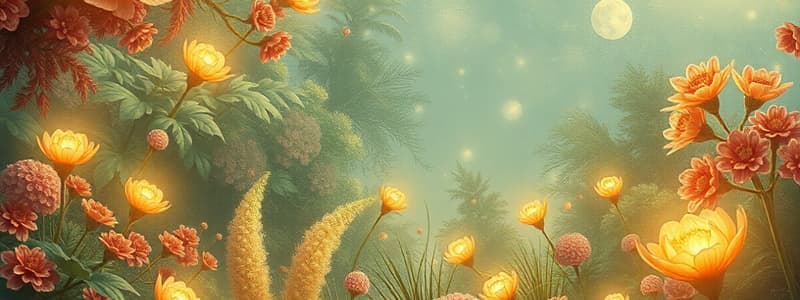Podcast
Questions and Answers
Under what climate conditions would you expect pubescence to be common?
Under what climate conditions would you expect pubescence to be common?
- Cool and windy conditions (correct)
- Hot and dry conditions (correct)
- Hot and wet conditions
- Hot and windy conditions
All plants are autotrophs.
All plants are autotrophs.
False (B)
What are the two major steps of photosynthesis?
What are the two major steps of photosynthesis?
Light reaction and Dark reaction
Plants can acclimatize to changing light intensities with shifts in ______.
Plants can acclimatize to changing light intensities with shifts in ______.
What is the light compensation point?
What is the light compensation point?
What enzyme is most associated with nitrogen in plants?
What enzyme is most associated with nitrogen in plants?
Photorespiration exclusively harms plants.
Photorespiration exclusively harms plants.
Match the following types of organisms with their energy sources:
Match the following types of organisms with their energy sources:
Flashcards are hidden until you start studying
Study Notes
Pubescence
- Pubescence is common in hot and dry conditions, where evaporative cooling is ineffective.
- Pubescence can also be common in cool and windy conditions to reduce water loss and heat conduction or convection.
- It is less likely in hot and wet conditions due to the effectiveness of evaporative cooling.
- It is also less likely in hot and windy conditions because convective cooling is possible.
Energy Sources
- Autotrophs obtain their energy by converting radiant energy from sunlight (photosynthesis) or inorganic compounds (chemosynthesis).
- Heterotrophs obtain their energy by consuming organic compounds from other organisms.
- Not all plants are autotrophs.
- Some plants, like Dodder (a holoparasite), are heterotrophs, obtaining energy from other plants.
- Mistletoe is a hemiparasite, photosynthetic but obtaining nutrients, water, and some of its energy from the host plant.
- Not all animals are heterotrophs.
- Some animals, like sea slugs, have functional chloroplasts taken from the algae they consume.
Photosynthesis
- Photosynthesis utilizes sunlight to convert CO2 into organic compounds.
- Chemosynthesis uses energy from inorganic compounds to produce carbohydrates.
- Photosynthesis has two main steps: the light reaction and the dark reaction.
- The light reaction uses light energy to split water, generating ATP and NADPH.
- The dark reaction fixes CO2 in the Calvin cycle and synthesizes carbohydrates.
- Light response curves show the relationship between light intensity and photosynthetic rate.
- The light compensation point is where CO2 uptake balances CO2 loss by respiration.
- The saturation point is when photosynthesis stops increasing despite increasing light intensity.
Factors Affecting Photosynthetic Rates
- Acclimatization: Plants can adapt to changing light intensities by shifting their light response curves.
- Local Adaptations: Plants from different climates have evolved enzyme forms with different optimal temperatures.
- Nutrients: Nitrogen plays a crucial role in photosynthesis, mainly found in Rubisco and other photosynthetic enzymes.
- Trade-offs: High nitrogen content in leaves can increase their susceptibility to herbivory.
- Rubisco: This enzyme has two activities: the carboxylase reaction (photosynthesis) and the oxygenase reaction (photorespiration).
- Photorespiration: While usually seen as a wasteful process, it might offer protection against damage at high light levels.
Studying That Suits You
Use AI to generate personalized quizzes and flashcards to suit your learning preferences.



